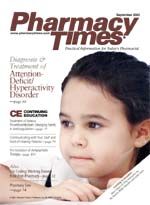Publication
Article
Pharmacy Times
Crestor (Rosuvastatin, ZD4522)
Coronary heart disease (CHD) is the number-1 cause of death in both men and women in the United States.1 Evidence suggests that low-density lipoprotein cholesterol (LDL-C) blood levels are directly correlated with CHD events. The 3-hydroxy-3-methylglutaryl coenzyme A (HMG-CoA) reductase inhibitors (RIs), also called statins, have proven to be the best agents available for reducing LDL-C.2 Literature indicates, however, that only 18% of patients are treated to their goal LDL-C levels as defined by the National Cholesterol Education Program?Adult Treatment Panel III (NCEP-ATP III) guidelines.3 The introduction of a statin with improved efficacy at its starting dose, decreased drug interactions, and minimal adverse effects would be optimal for control of cholesterol levels. Rosuvastatin (Crestor), developed by Shionogi & Co and licensed to AstraZeneca, is a third-generation (pure enantiomer) HMG-CoA RI recently approved by the FDA for the treatment of hypercholesterolemia.
Pharmacology
Statins decrease the production of cholesterol by inhibiting the rate-limiting enzyme HMG-CoA reductase. As a result, there is an upregulation of LDL receptors by hepatocytes, increasing the clearance of LDL-C.4 Crestor is a relatively hydrophilic (polar methane sulfonamide group) synthetic HMG-CoA RI. It has a half-life of about 20 hours, making its cholesterol-lowering capability equal when given at any time during the day.
Clinical Trials
Several clinical trials have compared Crestor with marketed statins, with Crestor showing favorable results. One randomized, double-blind, placebocontrolled, multicenter study compared the effectiveness of Crestor with that of atorvastatin in 516 patients with type IIa or type IIb hypercholesterolemia. Patients included in the study had an LDL level of 160 to 250 mg/dL and a triglyceride level 400 mg/dL. The study compared the effectiveness of Crestor 5 mg, Crestor 10 mg, atorvastatin 10 mg, and placebo for 12 weeks, with the primary end point of reducing LDL-C. Both Crestor doses showed a statistically significant greater reduction in LDL-C than atorvastatin. Additionally, Crestor was significantly more effective than atorvastatin in increasing high-density lipoprotein cholesterol levels, in decreasing total cholesterol levels, and in the percentage of patients reaching their LDL-C goals as defined by the NCEP-ATP III guidelines.5
Safety
Crestor undergoes minimal hepatic metabolism (~10%), mostly by isoenzymes 2C9 and 2C19, and it has essentially no metabolism via the 3A4 pathway. 6 In clinical trials, drug?drug interactions with cyclosporine, warfarin, and gemfibrozil have been evident. The majority of the parent compound is excreted unchanged in the feces. The adverse-effect profile of Crestor has been shown to be similar to that of the other statins. Rare occurrences of rhabdomyolysis have been reported with higher-than-recommended doses (80 mg) of Crestor. Additionally, uncomplicated myalgia has been reported in the Crestor-treated patients, and they should be monitored for this side effect.
Like other statins, Crestor has been related to biochemical liver abnormalities. Liver function tests should be done prior to initiation of therapy, 12 weeks following initiation, at dosage increases, and periodically thereafter. Crestor is classified as a pregnancy category X drug and should not be initiated in women who are pregnant or may become pregnant.
Outlook
Crestor is available as 5-, 10-, 20-, and 40-mg tablets. Although each therapy should be individualized, the suggested starting dose of Crestor is 10 mg once daily. In clinical trials, Crestor was shown to be more effective than marketed statins in a variety of dosing ranges. With its increased potency, Crestor may have an advantage over marketed products in achieving NCEPATP III goals.
For a list of references, send a stamped, self-addressed envelope to: References Department, Attn. D. Ryan, Pharmacy Times, 241 Forsgate Drive, Jamesburg, NJ 08831; or send an e-mail request to: [email protected].

Newsletter
Stay informed on drug updates, treatment guidelines, and pharmacy practice trends—subscribe to Pharmacy Times for weekly clinical insights.






